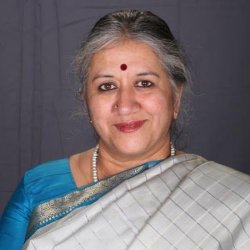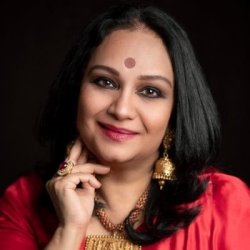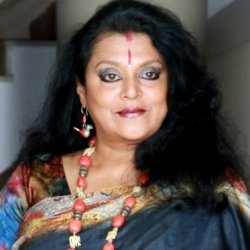
|   |

|   |
 e-mail: leelakaverivenkat@gmail.com Animated discussion on to be or not to be of Guru-Shishya March 3, 2021 The relevance of the Guru/shishya tradition in the contemporary ethos became the focus of animated webinar discussion in an event hosted by Sanjay Kumar Joshi's Parampara Dance and Music Forum. With Meenakshi Ravi as moderator, the panel interaction, involving senior dancers Swapnasundari, Pushkala Gopal, Prathibha Prahlad, Prerana Shrimali and Alekhya Punjala, voiced a blend of attitudes - with irreverence, at times, hitting a peak.  Pushkala Gopal  Alekhya Punjala Starting on a sober conventional note, both Pushkala Gopal and Prerana Shrimali shared the view that since our oral performing art traditions, handed down over several generations of transmission were based on a basic grammar, unlike a visual art like painting, the Guru trained in that tradition alone remained the conduit to transmit the art form to the next generation - which always had the right to push boundaries, while not departing from the basic stylistic concerns of the art form. There was tacit agreement that the ancient Gurukul system, by its adaptation into the institutionalised teaching method of today, had already been somewhat emasculated. In the ancient Gurukul, the aspirant living in the Guru's abode sharing household duties, imbibed the essence of an art form through a lot of intangible learning, away from the formal classroom teaching, flowing from the proximity to the Guru. Alekhya Punjala felt that even in its present form, transplanted into a digital world, the system was not without its advantages. She gave the example of her female Guru having learnt from the greatest of Kuchipudi masters like Lakshmi Narayana Sastry and others, imparting to her the best of the art form. Prathibha Prahlad erupted about what people deemed a sacrosanct relationship, becoming totally manipulative today. Gurus, far from the worshipful "Gurur Brahma, Vishnu, Maheswara" image were too full of human frailties and she did not hesitate in using strong language to condemn her last Bharatanatyam guru, who had subjected her to trauma, his behaviour towards her altering with attempts at physical intimacy, abhorrent to the then 25 year old, who found no court of appeal, or way of seeking help. Resorting to unfair preferential treatment, he also started using blackmailing tactics like hiking fees and charging exorbitantly for her concerts. Contours of the relationship drastically changed and she began to feel strangulated. She discussed with her abhinaya guru Kalanidhi Narayanan, in spite of whose mediation, matters did not improve, and she had to finally stop learning from him. The Guru, Prathibha continued had been exalted to the level of a god, what with the art promoting bodies like the Government and institutions like the ICCR,using the Guru as a promotional tool, intoning about the exclusivity of this Guru/Shishya concept, as a haloed part of our past. And today, when everybody and anybody running a classroom to teach calls himself a 'Guru', the term had been stripped of all exclusivity. Swapnasundari was equally critical about this "harvested", "packaged and exported" so called fundamental pillar of India's classical dance. She believed that in a world where mutually profitable results were the order of the day, the Guru acted as coach, instructor, promoter, facilitator and supplier of artistic material. As against this, the shishya was a self- promoter, imitator, a brand advertiser, a tool and bonded labour. Looking at the relationship in reverse, the role of the shishya was equally important and both were playing roles aimed at 'comfortable dividends'. Translated into a digital world, the concept of sadhana, the bedrock of the shishya's relationship with the guru, was forgotten. The salutation 'Na-ma-ha' really meant that the Guru belonged to that sacred space -so much so that a student pleaded forgiveness for even having the temerity to utter his name (which explains why Kathak dancers put hand to ear whenever they mention the name of the Guru.) Prathibha found this gesture of the Kathak dancer very annoying. Young dancer Mithun Shyam's post-discussion intervention was that he had been taught to chant at the start of his training the verse: Om SahanaaVavatu Sahanau Bhunaktu Saha Veeryam Karavaavahai Tejaswi Naavadhitamastu Maa Vidvishaavahai Om Shanti Shanti Shantihi exhorting both teacher and student on working with concentration and vigour, the joint effort evoking brilliance and understanding. The last line "May it not give rise to hostility and lack of understanding", clearly puts equal responsibility on student and teacher to create the right kind of energy.  Prathibha Prahlad Prathibha Prahlad's rebuttal was that this sloka as a start to any class or performance was an exception and did not apply to the usual practice, wherein it was always the shishya being worshipful to the Guru, that was emphasised. She also cut short Swamimalai K. Suresh who in his post-discussion intervention tried to dilate on how he benefitted from the wonderfully knowledgeable guru Rajaratnam Pillai. Prathibha countered the reference as irrelevant, the subject under discussion being, not about how much the Guru knew, for all Natyacharyas were highly knowledgeable, her own Guru being one of the best in the field. Here one was putting the search light over the relationship with the student. The Guru, as far as one knows, can only reveal the path and thereafter it is up to the student to use the means for attaining higher goals and one knows the same teacher can turn out myriad students, with no two alike. Yet another Kathak student's take was that the shishya's bond with the single preceptor through long mental and physical pursuit, becomes so strong, as to be 'more than the gandabandh tie.' Pushkala Gopal made a point that tradition allows for flexibility. And the way one relates with the Guru in today's scenario, could well be different. Any Guru demanding coercive sex as guru dakshina (and instances while prevalent in traditions are extremely rare in Bharatanatyam circles) cannot be condoned, and that such an experience can be traumatising is undeniable. But in today's 'Me Too' age, I have known students who have walked out with a firm refusal and found another teacher. I also know of dancers who as students of masters, have told me that they believe that it is only with the committed student willing to pay the ultimate price, that a Guru will share the real treasures of the tradition chest - kept a close secret by the torch bearer.  Prerana Shrimali Swapnasundari observed that conjugation with the shishya was mentioned as one of the five cardinal sins (pancha maha paapa). Gurus, sought after for their prowess in their discipline, are also fallible humans and even as the Acharya has been extolled in our tradition, Gurus have not always been models of morality - or why would our ancient literature have characters like Guru Dronacharya, the most exalted of Gurus asking for Ekalavya's thumb as guru dakshina - and that when he was only the 'manasika' guru for the youngster, whose approach to learn under the Guru had been rudely turned down - and for the lowest of reasons that a Guru of the Kshatriyas, Drona, could not stoop so low as to teach a low born! Pushkala Gopal brought out a salient point, that in England where she has been teaching for years now, rules were prescribed for an ideal teacher - and these were frequently emphasised. The flexibility which tradition allows has seen the Guru-shishya interaction change according to the needs of the time, a point Prerana Shrimali also emphasized, while also pointing that she as a student could never question the Guru, and yet she had been given the best of the Jaipur Gharana tradition by him. But the word Guru being misused to hide behind hoary antiquity was wrong. Prerana continued that one had to pass through several levels of teaching before the guru becomes a Nayak and then aspire for the final title of 'Maharaj' requiring several distinctions. Kasi Aysola working in the States, also in his intervention mentioned that art could be handed down only by a master teacher.  Swapnasundari Swapnasundari brought out a complication peculiar to today's art situation. Her take was that gender relationship been Guru and Shishya (with more and more women teachers taking over and male teachers dwindling) alone is not the problematic area. When the teacher too (unlike the past where non performing Gurus only taught) is a successful performer (in a sense, competing for the same space) the relationship of Guru and shishya becomes more complex. Loyalty flounders and a feeling of insecurity (in student or teacher?) creeps in. Swapna railed against erstwhile students, always on the lookout for performance opportunities (goaded and helped by relatives and others) using the name of the Guru as licence. Their disloyalty to her (mainly pinpointed against performers who had learnt under her) apart from using her name, comprised using her music and what she had choreographed, and adding to this repertoire, self-created productions - all presented under the name of the tradition she had given a new lease of life to - some even laying claim to researches into the Devadasi tradition in Andhra Pradesh. She strongly repudiated their calling her Guru, while going against all tenets of shishya loyalty. Our art scene has created a ticklish situation. Really speaking, there can and should be no competition between unequals like the Guru with stature and depth, accruing out of years of art experience and research on one side and on the other, the student who along with promising talent and advantage of youthful vitality is working to find some space in the art scenario. Any art situation in which one is in competition with the other, is doing great disservice to the art form, for it becomes demeaning for the Guru, leading, in some cases, to over confidence in the student and above all it corrodes the atmosphere where the Guru should rejoice in the students' progress as a feather in his cap. Swapnasundari's reference was obviously to Vilasini Natyam, whose formalised movement alphabet owes much to what she acquired through her personal and intense research into the Andhra Devadasi tradition, coupled with her own additions (through research into the Nritta Ratnavali, advised by late Sri Arudra) while having to fill gaps caused by the Devadasis' amnesia and lack of recall - stemming from the trauma of societal rejection. Among these, one time students, introduced to this tradition compiled by her in a certain manner, still mention her name as Guru - some performing from her repertoire - and expanding with one's own creations Swapnasundari feels do not comply with what she envisions as the tradition. The teacher trying to accommodate a busy performance schedule with teaching and the student, learning while looking for opportunities to perform have changed the art scene in this fast moving world. Practices and institutions which have come down to us from a long past, need to be looked at in a more matter of fact manner, discarding all the hyperbole we have surrounded them with. But also, anything which has come from a long past, can spread only through a teacher - call him (or her) Acharya, teacher, whatever - without diminishing further the connotation of the term 'Guru'. What Swapnasundari, one of the finest scholar/artists of post independent India, has is too precious to be lost in animosity and bitterness.  Writing on the dance scene for the last forty years, Leela Venkataraman's incisive comments on performances of all dance forms, participation in dance discussions both in India and abroad, and as a regular contributor to Hindu Friday Review, journals like Sruti and Nartanam, makes her voice respected for its balanced critiquing. She is the author of several books like Indian Classical dance: Tradition in Transition, Classical Dance in India and Indian Classical dance: The Renaissance and Beyond. Comments * Congratulations to Narthaki.com for following the Webinar on Guru-Shishya organised by Parampara and for publishing an almost faithful report of it. I am posting this response on my FB page, and marking the same to Narthaki with the request that my response be carried by Narthaki.com in keeping with the fair practises which it has come to be known for. This response is limited to observations made by veteran dance critic Leela Venkataraman, with pertinence to me. I do not speak for the other distinguished panelists of this Webinar. A) I am surprised that a senior and well -regarded dance commentator such as Leela Venkataraman ji deviated from her near-faithful reportage of the Webinar, with the remark (her own supposition) that my comments referred to Vilasini Natyam in particular. I have trained many more dancers in Kuchipudi than in Vilasini Natyam. Some of my Kuchipudi students had the honour of having their performances reviewed by her. Hence I wonder why she drew the conclusion that my views are restricted to Vilasini Natyam alone! I have been long engaged (both as a student and performer) with three performing traditions over four decades and have also been a teacher of two out of those three traditions. Nothing I say needs necessarily to be restricted to any one of them. B) Unambiguous expression of my opinions based on my own beliefs & principles, and statement of my unorthodox views about Guru-Shishya relationship, do not amount to bitterness or animosity as the writer concludes. An artist is an individual too, who has the right of choice of an ideological position appropriate for himself or herself within a system. As such, I reject a role within the formula based relationship in the world of Indian performing arts, that is presently a bad fit for me. Consequently, I reject the term "Guru "for myself and "Shishya " for those I have taught or am teaching presently since these terms have come to carry too many connotations which beg serious re-examination. I am hopeful that a new dynamic, re-defining the role of the student as well as teacher would eventually emerge through an organic process and as a natural outcome of the churning now taking place within the new ecosystem, wherein traditional Indian performing arts are still floundering to find a meaningful new direction. Until that happens, the roles and responsibilities of the student - teacher within the so-called "Guru Shishya " relationship will remain ill-defined. There must be many more honest discussions amongst the fraternity of traditional performing artists. Or else, manipulators and exploiters amongst students and teachers alike, will continue to flourish, by taking safe cover under the shroud of protection which is presently offered by this system, much to the detriment of the health of our well-loved performing traditions. I strongly believe that it is time for many more artists to step outside their comfort zones, help to deconstruct the 'formula Guru-Shishya' myth and join hands to fight the ills perpetuated in its name. It is obvious that there are gaps and flaws in that system. There is no animosity in saying that nor is there bitterness. That is the truth, even if it is unpalatable. I am happy that Narthaki.com has taken note of a Webinar which is a step in this direction. I also appreciate that a senior dance critic like Leela Venkataraman took out valuable time to listen to a Webinar initiated by an emerging forum for dialogue, like Parampara. -- Swapnasundari (March 4, 2021) * Having had my Arangetram in Chennai in 1969, I can say with personal experience that in Bharatanatyam parlance of those times, 'Vathiyaar Yaaru?' was the common term. 'Guru' could have been a term more in use in the North. As books came out, our writers and literati grew and the word Guru became the standard. I distinctly remember a round of lec-dems with 'Guru' Kelucharan being introduced by Sonal Mansingh in late sixties, and it is possible that other classical styles had started to use this. Tamil forms of print favoured Natana Aasiriyar as the description. We know that Kathakali used/uses the word 'Asan'. I agree with Swapna that a revision of the terms 'Guru' and 'Sishya' are called for. The practice has thrown up too many variants in our current context, and the historical notion of sishya-parampara has changed circumstantially. In the realm of new works created by teacher/choreographers it is again difficult to define where the cut off is, if a student cannot practise or teach or use material acquired from or through the teacher. The works of dancer Padma Subrahmanyam and Swapnasundari in Vilasini Natyam clearly have an enormous investment by the individual in the creation and growth of the Natya forms they have revealed and practised. So the question of intellectual property needs to be discussed and defined. I am on the same page as young Mithun Shyam, as 'Sahana Vavatu' does form a part of our teaching and learning ethos and has done for a good few decades, contrary to Prathibha's observation in the webinar. And my 'our' includes a community of Natya teachers. I am awed by the attention to detail in Leela Venkataraman's report and can read between the lines to see that some of her extrapolations come from her experience and understanding of the field and its players, underpinning what was gleaned from the webinar. While thanking Narthaki and Leelaji for the attention the webinar has received, I look forward to movement amongst the activists within the field to address and approach solutions. - Pushkala Gopal (March 4, 2021) Post your comments Pl provide your name and email id along with your comment. All appropriate comments posted with name and email id in the blog will also be featured in the site. |